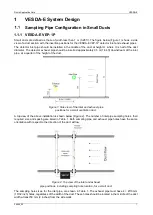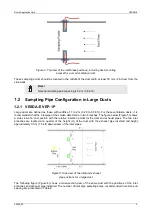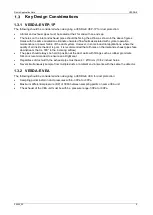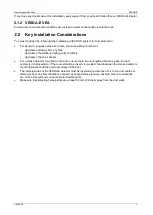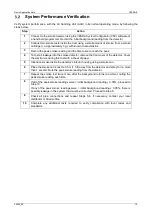
Ducts Application Note
VESDA-E
35424_02
6
2
VESDA-E System Installation
Environmental Conditions
2.1.1 VESDA-E VEP-1P
You will need equipment to measure the following environmental conditions when installing a VESDA-E system
in a duct:
•
Temperature.
•
Humidity.
•
Static Pressure – the pressure generated by the fan to deliver a specific flow-rate in the duct. This
pressure is a function of the flow-rate and impedance of the duct system.
•
Air Pressure.
•
In air-return ducts, the smoke detector must be installed where
the static pressure is above −500 Pa
and the air velocity in the duct is below 20 m/s or, converted to volumetric flow rate (m3/hr) = velocity
× duct area.
•
Always vent the exhaust pipe back into the ventilation duct, even when the duct pressure is sometimes
< 20 Pa, because the duct system operation may change in the future.
Condensation may occur when the dew point temperature of the air in the ventilation duct is at or above the
ambient temperature of the area where the smoke detector is installed. This usually occurs when the
temperature of the humid air in the duct is higher than the ambient temperature of the air outside the duct,
where the detector is to be installed, and the temperature of the air inside the sampling pipes of the detector.
You should measure the temperature and humidity both inside the duct and in the area where the detector will
be installed. If the results indicate that condensation may be a problem, refer to the ‘Duct Sampling and
Condensation’ section of the Pipe Network Installation Manual for advice on how to modify the design. The
Pipe Network Installation Manual (Document Number 10255) forms part of the VESDA-E System Design
Manual.
One solution for combating condensation is to mount the detector on its side (Figure 7). This places the laser
chamber higher than the aspirator so that any water in the inlet pipe does not reach the detector chamber.
Figure 7: VESDA-E VEP-1P detector sideways mounting
solution, to combat condensation.
The sampling pipe should be removed from the detector regularly for inspection, especially during winter, to
determine whether any condensation is forming inside the pipes.
Smoke tests should be conducted regularly during the first two months following installation. If the smoke tests
fail, condensation may have affected the air filter in the detector. Replace the air filter and re-test. The
condensation problem will need to be addressed by following the methods described above.




